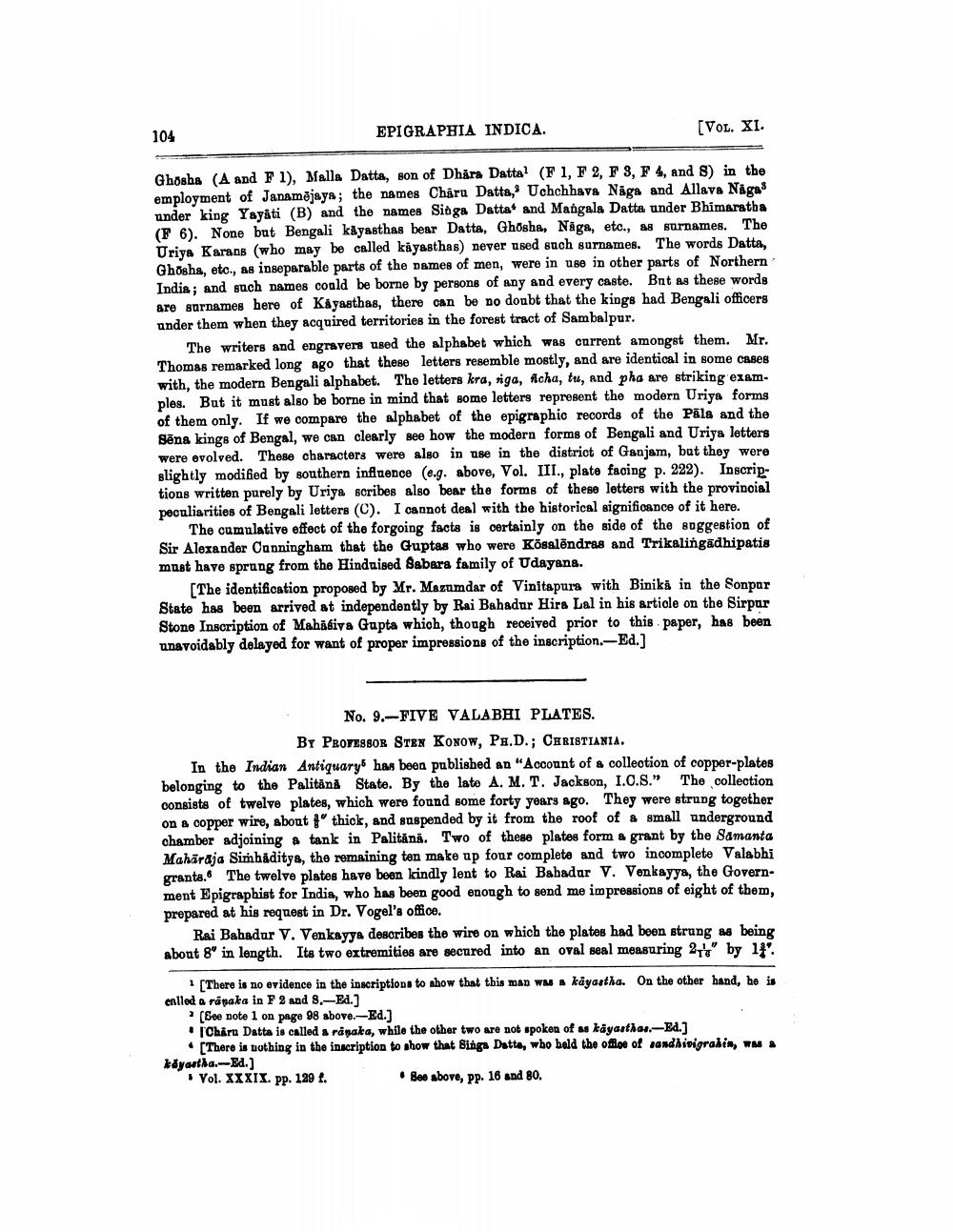________________
104
EPIGRAPHIA INDICA.
(VOL. XI.
Ghosha (A and F 1), Malla Datta, son of Dhåra Dattal (F1, F2, F3, F4, and 8) in the employment of Janamējaya; the names Charu Datta, Uchchhava Någa and Allava Någas under king Yayati (B) and the names Singa Dattat and Mangala Datta under Bhimaratha (F 6). None but Bengali kåyasthas bear Datta, Ghosha, Någa, etc., as surnames. The Uriya Karans (who may be called kayasthas) never used such surnames. The words Datta, Ghosha, etc., as inseparable parts of the names of men, were in use in other parts of Northern India, and such names could be borne by persons of any and every caste. But as these words are surnames here of Kayasthas, there can be no doubt that the kings had Bengali officers under them when they acquired territories in the forest tract of Sambalpur.
The writers and engravers used the alphabet which was current amongst them. Mr. Thomas remarked long ago that these letters resemble mostly, and are identical in some cases with, the modern Bengali alphabet. The letters kra, riga, ficha, tu, and pha are striking exam. ples. But it must also be borne in mind that some letters represent the modern Uriya forms of them only. If we compare the alphabet of the epigraphic records of the Pala and the Sēna kings of Bengal, we can clearly see how the modern forms of Bengali and Uriya letters were evolved. These characters were also in use in the district of Ganjam, but they were slightly modified by southern influence (e.g. above, Vol. III., plate facing p. 222). Inscriptions written purely by Uriya scribes also bear the forms of these letters with the provincial peculiarities of Bengali letters (C). I cannot deal with the historical significance of it here.
The cumulative effect of the forgoing facts is certainly on the side of the suggestion of Sir Alexander Cunningham that the Guptas who were Kõgalēndras and Trikalingādhipatis must have sprung from the Hinduised Sabara family of Udayana.
[The identification proposed by Mr. Mazumdar of Vinitapura with Biniks in the Sonpar State has been arrived at independently by Rai Bahadur Hira Lal in his article on the Sirpar Stone Inscription of Mahābiva Gupta which, though received prior to this paper, has been unavoidably delayed for want of proper impressions of the inscription.-Ed.)
No. 9.-FIVE VALABHI PLATES.
BY PROTESBOR STEN KONow, Ps.D.; CHRISTIANIA. In the Indian Antiquary has been published an "Account of a collection of copper-plates belonging to the Palitană State. By the late A. M. T. Jackson, I.C.S." The collection consists of twelve plates, which were found some forty years ago. They were strung together on a copper wire, about f' thick, and suspended by it from the roof of a small underground chamber adjoining & tank in Palitana. Two of these plates form a grant by the Samanta Maharaja Simhaditya, the remaining ten make up four complete and two incomplete Valabhi grants. The twelve plates have been kindly lent to Rai Bahadur V. Venkayya, the Government Epigraphist for India, who has been good enough to send me impressions of eight of them, prepared at his request in Dr. Vogel's office.
Rai Bahadur V. Venkayya describes the wire on which the plates had been strung as being about 8' in length. Its two extremities are secured into an oval seal measuring 270" by 14".
[There is no evidence in the inscriptions to show that this man wa a kayantha. On the other hand, he is enlled a rapaka in F 2 and 8.-Ed.)
(See note 1 on page 98 above. -Ed.]
Chåru Datta is called a rapaka, while the other two are not spoken of as kayasthas-Ed.) . There is nothing in the inscription to show that Singa Datta, who beld the office of sandhinigrahin, WM bayartha.--Ed.] • Vol. XXXIX. pp. 129 t.
See above, PP. 16 and 80.




